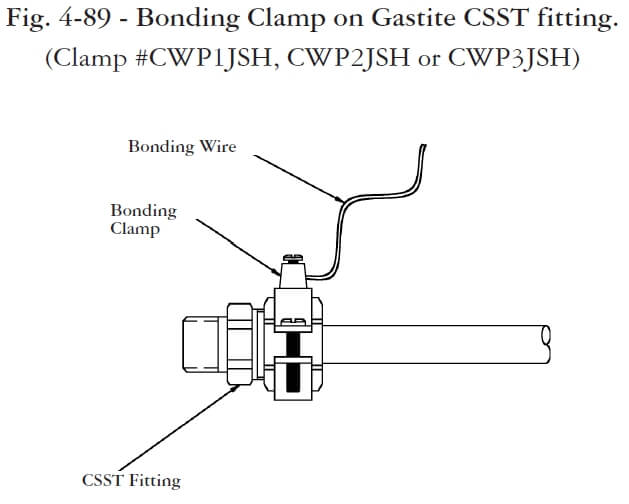CSST stands for Corrugated Stainless Steel Tubing. If you own a newer home or you’ve recently added gas lines to your home, there’s a good possibility that someone used CSST. This is a relatively new, flexible gas line used all over the country. The building code doesn’t have a ton of rules for CSST; they mostly say to follow the manufacturer’s instructions. Each manufacturer has a large exhaustive document, most of which are pretty similar, as they should be.
CSST needs to be bonded. The most common issue with CSST is a system that lacks proper bonding. Bonding the CSST means that you’re making sure it’s at the same electrical potential as everything else. If CSST is installed without being properly bonded to current standards, you have an increased risk for damage to the material from a nearby lightning strike. If CSST is damaged, it can leak gas and cause an explosion and/or a fire. To the best of our knowledge, all manufacturers of CSST began implementing specific bonding requirements around 2006.

What about existing installations? Building codes have something called ‘grandfathering’. This means that if something was installed to code, it’s still a code-compliant installation today, even if the codes have changed significantly. The nice thing about being a home inspector is that we don’t get hung up on code requirements. If something is deemed unsafe due to a change in accepted residential construction standards, our Standard of Practice requires us to report on it, whether it met code at the time it was installed or not.
If CSST was installed to code in 2005 and the manufacturer didn’t have any special requirements for bonding at the time it was installed, the installation still meets code today. We will still recommend this important safety upgrade, however. The manufacturers of CSST have changed their installation requirements because they’ve learned that the old methods weren’t good enough. There is an unacceptable risk of fire from a nearby lightning strike with older systems.
Where does CSST need to be bonded, inside or outside of the house? It’s safe to have CSST bonded either inside or outside the house. There has been some confusion on this topic because early editions of the fuel gas code were picky about this, but the current version of the code doesn’t specify. You can bond CSST inside or outside.
Not only does the newest version of the code allow CSST to be bonded anywhere, but CSST manufacturers also allow CSST to be bonded anywhere. For example, Gastite says “The bonding clamp attachment point may be at any location within the gas piping system.”
What does proper bonding look like? There needs to be a separate bonding wire connected either to the rigid gas piping before the CSST, or directly to one of the CSST nuts. This is needed any time CSST is installed, even if it’s just a small amount. The bonding conductor must not be smaller than a 6 AWG copper wire or the equivalent size if made of aluminum. The diagram below shows an example of what this would look like when properly installed to today’s standards.

While the old method for bonding CSST required a connection at the main electric panel, this is no longer required by the national fuel gas code. The current Fuel Gas Code requires CSST to be bonded anywhere along the electrical service grounding electrode system. That means that the bonding conductor for CSST can be connected to the metallic water piping coming into the home, a ground rod at the exterior, or anywhere else on the service grounding electrode system. This change makes it much easier to properly bond CSST.
What defines the grounding electrode system? Check out section 250.52 of the National Electric Code, which lists the following:
- Metal Underground Water Pipe
- Metal In-ground Support Structure(s)
- Concrete-Encased Electrode
- Ground Ring
- Rod and Pipe Electrodes
- Other Listed Electrodes
- Plate Electrodes
- Other Local Metal Underground Systems or Structures
How can you know if you have CSST in your home? Look for flexible tubing with a yellow or black jacket that covers the ridges. CSST either has a yellow jacket or a black jacket. This material is not to be confused with an appliance connector, which might have a yellow coating that follows the contours of the ridges. The photo below shows the two different materials.

The bottom line is that if you have a home with CSST, you should make sure it’s properly bonded to today’s standards, regardless of whether the installation ‘met code’ when it was originally installed. Codes change for safety and performance. Also, if your electrician tells you that bonding the CSST may increase the risk of a lightning strike, or doesn’t need to be done because the old installation “meets code”, simply thank them for their time and call a different electrician.
Additional Information on CSST and bonding
- CSST Bonding from ICC – An excellent article from the International Code Council
- Basics of CSST – a brief description, a brief history, and some basic installation requirements
H/T: Structure Tech
